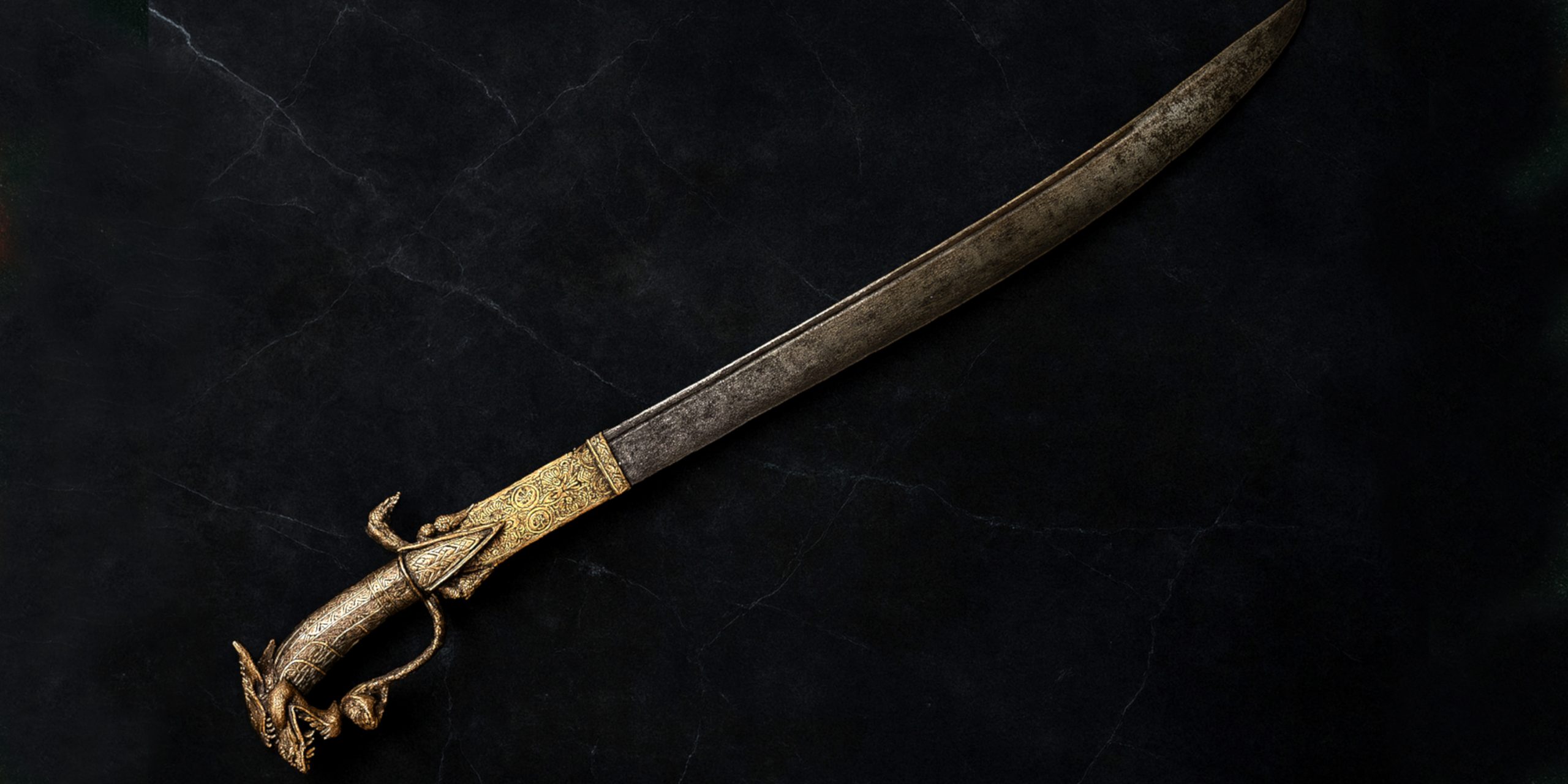
The Kastane is a distinctive ceremonial short sword from Sri Lanka, most commonly associated with the Sinhalese aristocracy during the Kandyan Kingdom era. Known for its ornate hilt featuring stylised mythical creatures and rich decoration, the Kastane was not a battlefield weapon but a symbol of power and rank. Though primarily ceremonial, it embodies centuries of artistic and cultural influences from South Asia, Europe, and the Islamic world.
Specification
| Feature | Description |
|---|---|
| Blade Length | Typically 16 to 24 inches (40 to 60 cm) |
| Overall Length | Around 20 to 30 inches (50 to 76 cm) |
| Blade Type | Single-edged, slightly curved or straight |
| Hilt | Highly ornate, often with lion, dragon, or makara motifs |
| Guard | Quillons curving towards the blade, decorative |
| Pommel | Finial, often zoomorphic or floral |
| Material | Steel blade, gold or brass fittings, ivory or wood grip |
| Use | Ceremonial, diplomatic, parade |
History and Evolution
The Kastane originated during the Kandyan Kingdom (1469–1815) and evolved as a court weapon used by nobility, officials, and royal guards. It emerged from the blending of indigenous styles with external influences, particularly Portuguese and Dutch during their colonial presence in Sri Lanka. The hilt design, incorporating mythical beasts like the makara, echoes both Hindu and Buddhist iconography, while European and Moorish guard shapes reveal cross-cultural craftsmanship.
The sword maintained its role even after the fall of the Kandyan Kingdom, often adapted in colonial uniforms to signify rank in local regiments. By the 19th century, Kastanes became more decorative than functional, produced mainly for ceremonial display or gifting.
Advantages and Disadvantages
Advantages:
- Symbolic richness: Embodies Sri Lankan identity and craftsmanship.
- Aesthetic appeal: Unique among world swords due to intricate zoomorphic hilts.
- Cultural continuity: Remains in ceremonial use in Sri Lanka to this day.
Disadvantages:
- Limited combat utility: Not designed for warfare or sustained duelling.
- Fragility in modern examples: Many are constructed primarily for show.
- Rarity in authentic form: Original 17th- to 18th-century examples are scarce.
Comparison with Similar Weapons
| Weapon | Origin | Function | Decorative Elements | Combat Capable? |
|---|---|---|---|---|
| Kastane | Sri Lanka | Ceremonial | Mythical beasts, gilded hilts | No |
| Talwar | India | Combat and status | Minimal decoration, curved blade | Yes |
| Kilij | Ottoman Empire | Combat | Stylised calligraphy, curve blade | Yes |
| Kris | Southeast Asia | Ceremonial/combat | Wavy blade, spiritual motifs | Occasionally |
| Moro Barong | Philippines | Combat | Heavily decorated but practical | Yes |
Legacy
The Kastane remains a key emblem of Sri Lankan heritage. It is still worn by officials during state ceremonies and military parades, particularly in Kandyan-style regalia. As a work of art, it reflects the island’s complex layers of cultural exchange, myth, and colonial history. Its unique form has made it a subject of interest for historians, curators, and collectors alike.
Where to See
Authentic Kastanes can be viewed at the following institutions:
- National Museum, Colombo – Houses ceremonial Kastanes from the Kandyan period.
- Victoria and Albert Museum, London – Contains examples collected during British colonial rule.
- Pitt Rivers Museum, Oxford – Features Kastanes with detailed provenance notes.
- Leiden Museum of Ethnology, Netherlands – Reflects Dutch colonial connections with Sri Lanka.
Collector’s Guide
Value and Availability:
- Authentic 17th–18th century Kastanes are rare and highly prized. They can sell from £5,000 to over £20,000, depending on provenance and condition.
- 19th-century ceremonial versions, often produced for colonial officials or public display, range from £1,000 to £5,000.
- Reproductions or modern ceremonial pieces are more widely available, generally valued between £200 and £800.
Auction Appearances:
- Sotheby’s and Bonhams have sold Kastanes from notable collections, particularly when linked to colonial officers or Sri Lankan dignitaries.
- Sri Lankan and European antique arms dealers occasionally offer specimens with reliable documentation.
Collector Tips:
- Verify the blade: Early Kastanes have forged blades with signs of use or ritual sharpening, while later ones are more decorative.
- Inspect the hilt detail: Authentic hilts have intricate hand-carved motifs, often inlaid with gold or semi-precious stones.
- Check provenance: Pieces with military or diplomatic ties often fetch higher prices.
The Kastane remains one of the most visually striking and culturally significant swords of South Asia. While its use in combat was negligible, its function as a symbol of rank, authority, and artistic excellence has ensured its place in both museum collections and private holdings worldwide.



